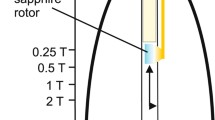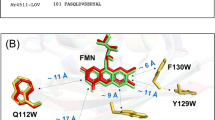Abstract
Moderate intensity SMF have been shown to act as a controller of the protic potential in the coherent milieu of the thylakoid membranes. SMF of the order of 60-500 mT induces memory-like effect in photosystem I (PSI, P, 723) emission with a correlated oscillation of photosystem II (PSII, P, 689) fluorescence emission at a temperature of 77 K. The observed magnetic perturbation that affects the thylakoid photon capture circuitry was also found to be associated with the bio-energetic machinery of the thylakoid membranes. At normal pH, SMF causes an enhancement of PSI fluorescence emission intensity (P, 723/P, 689 > 1), followed by a slow relaxation on the removal of SMF. The enhancement of the PSI fluorescence intensity also occurs under no-field condition, if either the pH of the medium is lowered, or protonophores, such as carbonyl cyanide chlorophenylhydrazine or nigericin are added (P, 723/P, 689 ≥ 2). If SMF was applied under such a low pH condition or in the presence of protonophore, a reverse effect, particularly, a reduction of the enhanced PSI emission was observed. Because SMF is essentially equivalent to a spin perturbation, the observed effects can be explained in terms of spin re-organization, illustrating a memory effect via membrane re-alignment and assembly. The mimicry of conventional uncouplers by SMF is also notable; the essential difference being the reversibility and manoeuvrability of the latter (SMF). Finally, the effect implies numerous possibilities of externally regulating the photon capture and proton circulation in the thylakoid membranes using controlled SMF.
Similar content being viewed by others
References
N. Belyavskaya, Biological effects due to weak magnetic field on plants, Adv. Space Res., 2004, 34, 1566–1574.
A. Hoff, Magnetic field effects on photosynthetic reactions, Q. Rev. Biophys., 1981, 14, 599.
H. Lee, Y.-C. Cheng and G. R. Fleming, Coherence dynamics in photosynthesis: protein protection of excitonic coherence, Science, 2007, 316, 1462–1465.
J. M. Olson, The FMO Protein, Photosynth. Res., 2004, 80, 181–187.
G. Panitchayangkoon, D. Hayes, K. A. Fransted, J. R. Caram, E. Harel, J. Wen, R. E. Blankenship and G. S. Engel, Long-lived quantum coherence in photosynthetic complexes at physiological temperature, Proc. Natl. Acad. Sci. U. S. A., 2010, 107, 12766–12770.
D. P. Small, N. Hüner and W. Wan, Effect of static magnetic fields on the growth, photosynthesis and ultrastructure of Chlorella kessleri microalgae, Bioelectromagnetics, 2012, 33, 298–308.
S. Pietruszewski, S. Muszynski and A. Dziwulska, Electromagnetic fields and electromagnetic radiation as non-invasive external stimulants for seeds (selected methods and responses), Int. Agrophysics, 2007, 21, 95.
P. Galland and A. Pazur, Magnetoreception in plants, J. Plant Res., 2005, 118, 371–389.
T. Ritz, T. Yoshii, C. Foerster and M. Ahmad, Cryptochrome: A photoreceptor with the properties of a magnetoreceptor?, Commu.Integr. Biol., 2010, 3, 24–27.
T. Yoshii, M. Ahmad, C. Helfrich-Förster, Cryptochrome mediates light-dependent magnetosensitivity of Drosophila’s circadian clock, PLoS Biol., 2009, 7, e1000086.
J. R. Norris, TRIPLET STATES AND PHOTOSYNTHESIS, Photochem. Photobiol., 1976, 23, 449–450.
A. Ishizaki and G. R. Fleming, Quantum coherence in photosynthetic light harvesting, Annu. Rev. Condens. Matter Phys., 2012, 3, 333–361.
I. Kassal, J. Yuen-Zhou, S. Rahimi-Keshari, Does coherence enhance transport in photosynthesis?, J. Phys. Chem. Lett., 2013, 4, 362–367.
M. Tikkanen, M. Nurmi, M. Suorsa, R. Danielsson, F. Mamedov, S. Styring, E.-M. Aro, Phosphorylation-dependent regulation of excitation energy distribution between the two photosystems in higher plants, Biochim. Biophys. Acta, Bioenerg., 2008, 1777, 425–432.
J. P. Dekker and E. J. Boekema, Supramolecular organization of thylakoid membrane proteins in green plants, Biochim. Biophys. Acta, Bioenerg., 2005, 1706, 12–39.
E. Shimoni, O. Rav-Hon, I. Ohad, V. Brumfeld and Z. Reich, Three-dimensional organization of higher-plant chloroplast thylakoid membranes revealed by electron tomography, Plant Cell Online, 2005, 17, 2580–2586.
N. Nelson, A. Ben-Shem, The complex architecture of oxygenic photosynthesis, Nat. Rev. Mol. Cell Biol., 2004, 5, 971–982.
Y. Evron, R. E. McCarty, Simultaneous measurement of ΔpH and electron transport in chloroplast thylakoids by 9-aminoacridine fluorescence, Plant Physiol., 2000, 124, 407–414.
S. Saphon and A. R. Crofts, The H+/e-ratio in chloroplasts is 2. Possible errors in its determination, Z. Naturforsch., C: Biosci., 1977, 32, 810–816.
T. Owens, S. Webb, L. Mets, R. Alberte and G. Fleming, Antenna size dependence of fluorescence decay in the core antenna of photosystem I: estimates of charge separation and energy transfer rates, Proc. Natl. Acad. Sci. U. S. A., 1987, 84, 1532–1536.
U. Schreiber, W. Bilger and C. Neubauer, Chlorophyll fluorescence as a nonintrusive indicator for rapid assessment of in vivo photosynthesis, in Ecophysiology of photosynthesis, Springer, 1994, pp. 49-70.
D. M. Kramer, J. A. Cruz and A. Kanazawa, Balancing the central roles of the thylakoid proton gradient, Trends Plant Sci., 2003, 8, 27–32.
K. Takizawa, J. A. Cruz, A. Kanazawa and D. M. Kramer, The thylakoid proton motive force in vivo. Quantitative, non-invasive probes, energetics, and regulatory consequences of light-induced pmf, Biochim. Biophys. Acta, Bioenerg., 2007, 1767, 1233–1244.
S. Theg, G. Chiang and R. Dilley, Protons in the thylakoid membrane-sequestered domains can directly pass through the coupling factor during ATP synthesis in flashing light, J. Biol. Chem., 1988, 263, 673–681.
H. Yamasaki, S. Furuya, A. Kawamura, A. Ito, S. Okayama and M. Nishimura, Induction of the H+ release from thylakoid membranes by illumination in the presence of protonophores at high concentrations, Plant Cell Physiol., 1991, 32, 925–934.
M. Huber, Introduction to magnetic resonance methods in photosynthesis, Photosynth. Res., 2009, 102, 305–310.
C. R. Timmel and K. B. Henbest, A study of spin chemistry in weak magnetic fields, Philos. Trans. R. Soc. London, A, 2004, 362, 2573–2589.
N. Bukhov and R. Carpentier, Alternative photosystem I-driven electron transport routes: mechanisms and functions, Photosynth. Res., 2004, 82, 17–33.
Y. Munekage and T. Shikanai, Cyclic electron transport through photosystem I, Plant Biotechnol., 2005, 22, 361–369.
H. Takahashi, S. Clowez, F.-A. Wollman, O. Vallon and F. Rappaport, Cyclic electron flow is redox-controlled but independent of state transition, Nat. Commun., 2013, 4.
S. Santabarbara, I. Kuprov, W. V. Fairclough, S. Purton, P. J. Hore, P. Heathcote and M. C. Evans, Bidirectional electron transfer in photosystem I: determination of two distances between P700+ and A1-in spin-correlated radical pairs, Biochemistry, 2005, 44, 2119–2128.
Y.-S. Jung, I. R. Vassiliev and J. H. Golbeck, Crossover of a high-spin (S = 7/2, 3/2) to a low-spin (S = 1/2) iron-selenium cluster in FA and FB of photosystem I on rebinding of PsaC onto P700-FX cores, JBIC, J. Biol. Inorg. Chem., 1997, 2, 209–217.
K. A. Campbell, W. Gregor, D. P. Pham, J. M. Peloquin, R. J. Debus and R. D. Britt, The 23 and 17 kDa extrinsic proteins of photosystem II modulate the magnetic properties of the S1-state manganese cluster, Biochemistry, 1998, 37, 5039–5045.
R. Inglis, C. C. Stoumpos, A. Prescimone, M. Siczek, T. Lis, W. Wernsdorfer, E. K. Brechin and C. J. Milios, Ferromagnetic manganese “cubes”: from PSII to single-molecule magnets, Dalton Trans., 2010, 39, 4777–4785.
Y. Kurashige, G. K.-L. Chan and T. Yanai, Entangled quantum electronic wavefunctions of the Mn4CaO5 cluster in photosystem II, Nat. Chem., 2013, 5, 660–666.
U. Heinen, O. Poluektov, E. Stavitski, T. Berthold, E. Ohmes, S. L. Schlesselman, J. R. Golecki, G. J. Moro, H. Levanon and M. C. Thurnauer, Magnetic-field-induced orientation of photosynthetic reaction centers, as revealed by time-resolved D-band electron paramagnetic resonance of spin-correlated radical pairs. II. Field dependence of the alignment, J. Phys. Chem. B, 2004, 108, 9498–9504.
Z. Zeng, D. Guenzburger and D. Ellis, Electronic structure, spin couplings, and hyperfine properties of nanoscale molecular magnets, Phys. Rev. B: Condens. Matter, 1999, 59, 6927.
B. Brocklehurst, Magnetic fields and radical reactions: recent developments and their role in nature, Chem. Soc. Rev., 2002, 31, 301–311.
G. Scott, Review of gyromagnetic ratio experiments, Rev. Mod. Phys., 1962, 34, 102.
D. J. Müller, Y. F. Dufrêne, Atomic force microscopy: a nanoscopic window on the cell surface, Trends Cell Biol., 2011, 21, 461–469.
D. J. Muller, AFM: A Nanotool in Membrane Biology†, Biochemistry, 2008, 47, 7986–7998.
R. García and R. Perez, Dynamic atomic force microscopy methods, Surf. Sci. Rep., 2002, 47, 197–301.
H. Kirchhoff, Molecular crowding and order in photosynthetic membranes, Trends Plant Sci., 2008, 13, 201–207.
M. Herbstová, S. Tietz, C. Kinzel, M. V. Turkina and H. Kirchhoff, Architectural switch in plant photosynthetic membranes induced by light stress, Proc. Natl. Acad. Sci. U. S. A., 2012, 109, 20130–20135.
D. Kaftan, V. Brumfeld, R. Nevo, A. Scherz and Z. Reich, From chloroplasts to photosystems: in situ scanning force microscopy on intact thylakoid membranes, EMBO J., 2002, 21, 6146–6153.
S. G. Chuartzman, R. Nevo, E. Shimoni, D. Charuvi, V. Kiss, I. Ohad, V. Brumfeld and Z. Reich, Thylakoid membrane remodeling during state transitions in Arabidopsis, Plant Cell Online, 2008, 20, 1029–1039.
A. Hazra, M. DasGupta, Phosphorylation-dephosphorylation of light-harvesting complex II as a response to variation in irradiance is thiol sensitive and thylakoid sufficient: modulation of the sensitivity of the phenomenon by a peripheral component, Biochemistry, 2003, 42, 14868–14876.
J. Bennett, K. E. Steinback and C. J. Arntzen, Chloroplast phosphoproteins: regulation of excitation energy transfer by phosphorylation of thylakoid membrane polypeptides, Proc. Natl. Acad. Sci. U. S. A., 1980, 77, 5253–5257.
M. Hipkins and N. R. Baker, Photosynthesis: energy transduction: a practical approach, IRL Press Limited, 1986.
C. Sigalat, Y. de Kouchkovsky and F. Haraux, Flow-force relationships in lettuce thylakoids. 2. Effect of the uncoupler FCCP on local proton resistances at the ATPase level, Biochemistry, 1993, 32, 10201–10208.
J. N. Sturgis, J. D. Tucker, J. D. Olsen, C. N. Hunter and R. A. Niederman, Atomic Force Microscopy Studies of Native Photosynthetic Membranes†, Biochemistry, 2009, 48, 3679–3698.
P. Manna and W. Vermaas, Lumenal proteins involved in respiratory electron transport in the cyanobacterium Synechocystis sp. PCC6803, Plant Mol. Biol., 1997, 35, 407–416.
G. Forti and A. M. Ehrenheim, The role of ascorbic acid in photosynthetic electron transport, Biochim. Biophys. Acta, Bioenerg., 1993, 1183, 408–412.
G. Cornic, N. G. Bukhov, C. Wiese, R. Bligny and U. Heber, Flexible coupling between light-dependent electron and vectorial proton transport in illuminated leaves of C3 plants. Role of photosystem I-dependent proton pumping, Planta, 2000, 210, 468–477.
L. Mustárdy, Development of thylakoid membrane stacking, in Oxygenic photosynthesis: the light reactions, Springer, 1996, pp. 59-68.
P. Mitchell, Chemiosmotic coupling in energy transduction: a logical development of biochemical knowledge, Springer, 1974.
Author information
Authors and Affiliations
Corresponding author
Rights and permissions
About this article
Cite this article
Bhattacharya, A., Chakraborty, M., Raja, S.O. et al. Static magnetic field (SMF) sensing of the P723/P689 photosynthetic complex. Photochem Photobiol Sci 13, 1719–1729 (2014). https://doi.org/10.1039/c4pp00295d
Received:
Accepted:
Published:
Issue Date:
DOI: https://doi.org/10.1039/c4pp00295d




